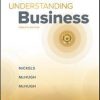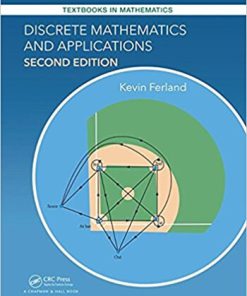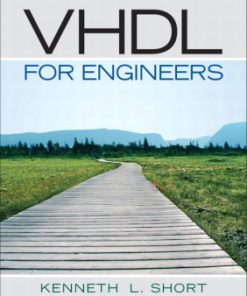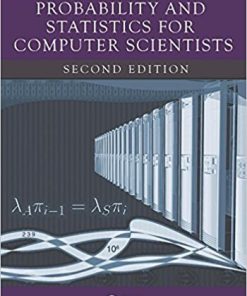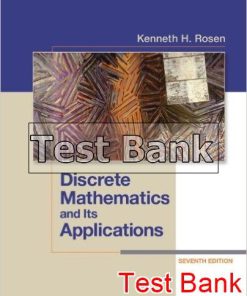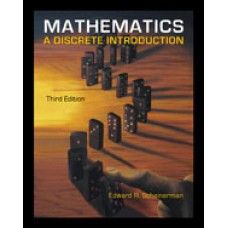Solution Manual for Discrete Mathematics for Computer Scientists Cliff L Stein, Robert Drysdale, Kenneth Bogart
$35.00 Original price was: $35.00.$26.50Current price is: $26.50.
Solution Manual for Discrete Mathematics for Computer Scientists Cliff L Stein, Robert Drysdale, Kenneth Bogart
Solution Manual for Discrete Mathematics for Computer Scientists Cliff L Stein, Robert Drysdale, Kenneth Bogart digital download immediately after payment is complete.
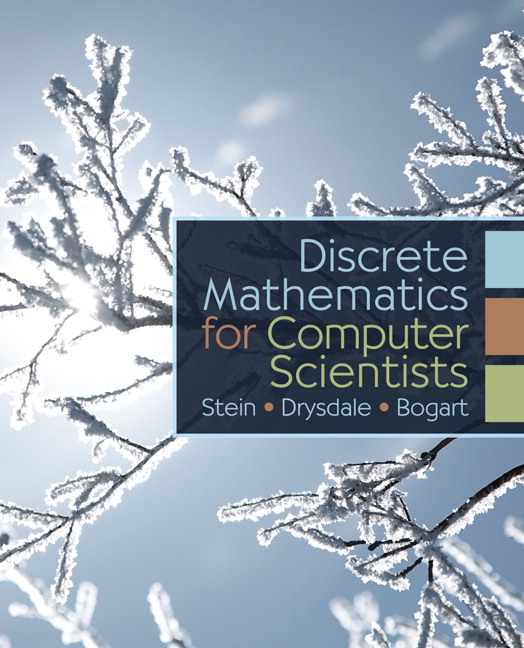
Product details:
- ISBN-10 : 0132122715
- ISBN-13 : 978-0132122719
- Author: Clifford Stein
Stein/Drysdale/Bogart’s Discrete Mathematics for Computer Scientists is ideal for computer science students taking the discrete math course.
Written specifically for computer science students, this unique textbook directly addresses their needs by providing a foundation in discrete math while using motivating, relevant CS applications. This text takes an active-learning approach where activities are presented as exercises and the material is then fleshed out through explanations and extensions of the exercises.
Table contents:
- CHAPTER 1 Counting
- 1.1 Basic Counting
- The Sum Principle
- Abstraction
- Summing Consecutive Integers
- The Product Principle
- Two-Element Subsets
- Important Concepts, Formulas, and Theorems
- Problems
- 1.2 Counting Lists, Permutations, and Subsets
- Using the Sum and Product Principles
- Lists and Functions
- The Bijection Principle
- k-Element Permutations of a Set
- Counting Subsets of a Set
- Important Concepts, Formulas, and Theorems
- Problems
- 1.3 Binomial Coeficients
- Pascal’s Triangle
- A Proof Using the Sum Principle
- The Binomial Theorem
- Labeling and Trinomial Coeficients
- Important Concepts, Formulas, and Theorems
- Problems
- 1.4 Relations
- What Is a Relation?
- Functions as Relations
- Properties of Relations
- Equivalence Relations
- Partial and Total Orders
- Important Concepts, Formulas, and Theorems
- Problems
- 1.5 Using Equivalence Relations in Counting
- The Symmetry Principle
- Equivalence Relations
- The Quotient Principle
- Equivalence Class Counting
- Multisets
- The Bookcase Arrangement Problem
- The Number of k-Element Multisets of an n-Element Set
- Using the Quotient Principle to Explain a Quotient
- Important Concepts, Formulas, and Theorems
- Problems
- CHAPTER 2 Cryptography and Number Theory
- 2.1 Cryptography and Modular Arithmetic
- Introduction to Cryptography
- Private-Key Cryptography
- Public-Key Cryptosystems
- Arithmetic Modulo n
- Cryptography Using Addition mod n
- Cryptography Using Multiplication mod n
- Important Concepts, Formulas, and Theorems
- Problems
- 2.2 Inverses and Greatest Common Divisors
- Solutions to Equations and Inverses mod n
- Inverses mod n
- Converting Modular Equations to Normal Equations
- Greatest Common Divisors
- Euclid’s Division Theorem
- Euclid’s GCD Algorithm
- Extended GCD Algorithm
- Computing Inverses
- Important Concepts, Formulas, and Theorems
- Problems
- 2.3 The RSA Cryptosystem
- Exponentiation mod n
- The Rules of Exponents
- Fermat’s Little Theorem
- The RSA Cryptosystem
- The Chinese Remainder Theorem
- Important Concepts, Formulas, and Theorems
- Problems
- 2.4 Details of the RSA Cryptosystem
- Practical Aspects of Exponentiation mod n
- How Long Does It Take to Use the RSA Algorithm?
- How Hard Is Factoring?
- Finding Large Primes
- Important Concepts, Formulas, and Theorems
- Problems
- CHAPTER 3 Reflections on Logic and Proof
- 3.1 Equivalence and Implication
- Equivalence of Statements
- Truth Tables
- DeMorgan’s Laws
- Implication
- If and Only If
- Important Concepts, Formulas, and Theorems
- Problems
- 3.2 Variables and Quantifiers
- Variables and Universes
- Quantifiers
- Standard Notation for Quantification
- Statements about Variables
- Rewriting Statements to Encompass Larger Universes
- Proving Quantified Statements True or False
- Negation of Quantified Statements
- Implicit Quantification
- Proof of Quantified Statements
- Important Concepts, Formulas, and Theorems
- Problems
- 3.3 Inference
- Direct Inference (Modus Ponens) and Proofs
- Rules of Inference for Direct Proofs
- Contrapositive Rule of Inference
- Proof by Contradiction
- Important Concepts, Formulas, and Theorems
- Problems
- CHAPTER 4 Induction, Recursion, and Recurrences
- 4.1 Mathematical Induction
- Smallest Counterexamples
- The Principle of Mathematical Induction
- Strong Induction
- Induction in General
- A Recursive View of Induction
- Structural Induction
- Important Concepts, Formulas, and Theorems
- Problems
- 4.2 Recursion, Recurrences, and Induction
- Recursion
- Examples of First-Order Linear Recurrences
- Iterating a Recurrence
- Geometric Series
- First-Order Linear Recurrences
- Important Concepts, Formulas, and Theorems
- Problems
- 4.3 Growth Rates of Solutions to Recurrences
- Divide and Conquer Algorithms
- Recursion Trees
- Three Different Behaviors
- Important Concepts, Formulas, and Theorems
- Problems
- 4.4 The Master Theorem
- Master Theorem
- Solving More General Kinds of Recurrences
- Extending the Master Theorem
- Important Concepts, Formulas, and Theorems
- Problems
- 4.5 More General Kinds of Recurrences
- Recurrence Inequalities
- The Master Theorem for Inequalities
- A Wrinkle with Induction
- Further Wrinkles in Induction Proofs
- Dealing with Functions Other Than n[sup(c)]
- Important Concepts, Formulas, and Theorems
- Problems
- 4.6 Recurrences and Selection
- The Idea of Selection
- A Recursive Selection Algorithm
- Selection without Knowing the Median in Advance
- An Algorithm to Find an Element in the Middle Half
- An Analysis of the Revised Selection Algorithm
- Uneven Divisions
- Important Concepts, Formulas, and Theorems
- Problems
- CHAPTER 5 Probability
- 5.1 Introduction to Probability
- Why Study Probability?
- Some Examples of Probability Computations
- Complementary Probabilities
- Probability and Hashing
- The Uniform Probability Distribution
- Important Concepts, Formulas, and Theorems
- Problems
- 5.2 Unions and Intersections
- The Probability of a Union of Events
- Principle of Inclusion and Exclusion for Probability
- The Principle of Inclusion and Exclusion for Counting
- Important Concepts, Formulas, and Theorems
- Problems
- 5.3 Conditional Probability and Independence
- Conditional Probability
- Bayes’ Theorem
- Independence
- Independent Trials Processes
- Tree Diagrams
- Primality Testing
- Important Concepts, Formulas, and Theorems
- Problems
- 5.4 Random Variables
- What Are Random Variables?
- Binomial Probabilities
- A Taste of Generating Functions
- Expected Value
- Expected Values of Sums and Numerical Multiples
- Indicator Random Variables
- The Number of Trials until the First Success
- Important Concepts, Formulas, and Theorems
- Problems
- 5.5 Probability Calculations in Hashing
- Expected Number of Items per Location
- Expected Number of Empty Locations
- Expected Number of Collisions
- Expected Maximum Number of Elements in a Location of a Hash Table
- Important Concepts, Formulas, and Theorems
- Problems
- 5.6 Conditional Expectations, Recurrences, and Algorithms
- When Running Times Depend on More than Size of Inputs
- Conditional Expected Values
- Randomized Algorithms
- Selection Revisited
- QuickSort
- A More Careful Analysis of RandomSelect
- Important Concepts, Formulas, and Theorems
- Problems
- 5.7 Probability Distributions and Variance
- Distributions of Random Variables
- Variance
- Important Concepts, Formulas, and Theorems
- Problems
- CHAPTER 6 Graphs
- 6.1 Graphs
- The Degree of a Vertex
- Connectivity
- Cycles
- Trees
- Other Properties of Trees
- Important Concepts, Formulas, and Theorems
- Problems
- 6.2 Spanning Trees and Rooted Trees
- Spanning Trees
- Breadth-First Search
- Rooted Trees
- Important Concepts, Formulas, and Theorems
- Problems
- 6.3 Eulerian and Hamiltonian Graphs
- Eulerian Tours and Trails
- Finding Eulerian Tours
- Hamiltonian Paths and Cycles
- NP-Complete Problems
- Proving That Problems Are NP-Complete
- Important Concepts, Formulas, and Theorems
- Problems
- 6.4 Matching Theory
- The Idea of a Matching
- Making Matchings Bigger
- Matching in Bipartite Graphs
- Searching for Augmenting Paths in Bipartite Graphs
- The Augmentation-Cover Algorithm
- Efficient Algorithms
- Important Concepts, Formulas, and Theorems
- Problems
- 6.5 Coloring and Planarity
- The Idea of Coloring
- Interval Graphs
- Planarity
- The Faces of a Planar Drawing
- The Five-Color Theorem
- Important Concepts, Formulas, and Theorems
- Problems
- APPENDIX A: Derivation of the More General Master Theorem
- More General Recurrences
- Recurrences for General n
- Removing Floors and Ceilings
- Floors and Ceilings in the Stronger Version of the Master Theorem
- Proofs of Theorems
- Important Concepts, Formulas, and Theorems
- Problems
- APPENDIX B: Answers and Hints to Selected Problems
- Bibliography
- Index
People also search:
discrete mathematics for computer scientists and mathematicians pdf
discrete mathematics for computer scientists john truss pdf
discrete mathematics for computer scientists truss
discrete mathematics for computer scientists and mathematicians solutions pdf
is discrete mathematics important for computer science
discrete mathematics for computer engineering
why is discrete math important for computer science
You may also like…
Solution Manual
Solution Manual
Solution Manual for Discrete Mathematics with Applications 5th Edition Susanna S. Epp


